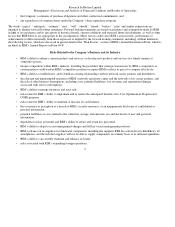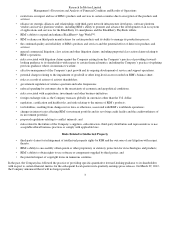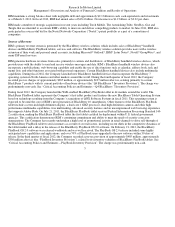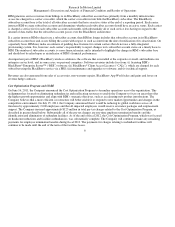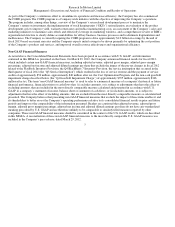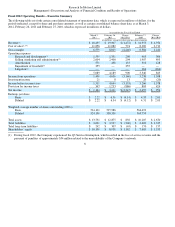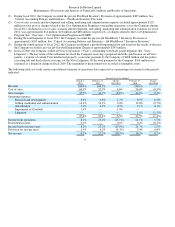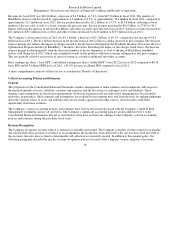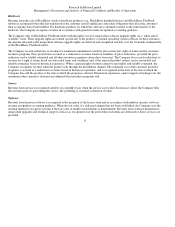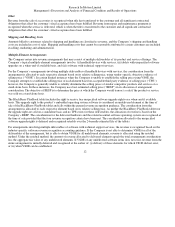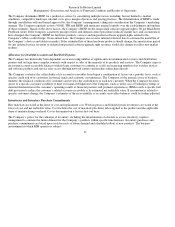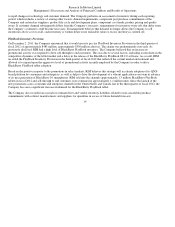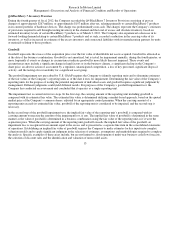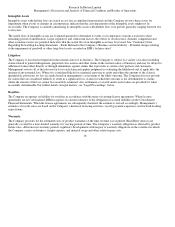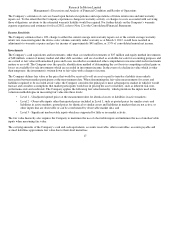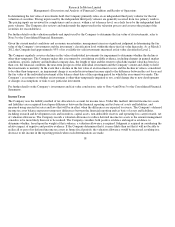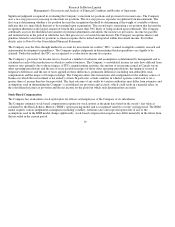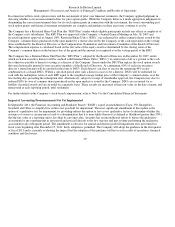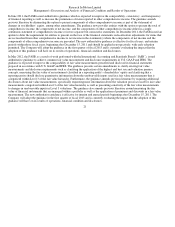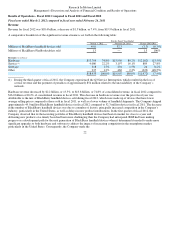Blackberry 2012 Annual Report Download - page 182
Download and view the complete annual report
Please find page 182 of the 2012 Blackberry annual report below. You can navigate through the pages in the report by either clicking on the pages listed below, or by using the keyword search tool below to find specific information within the annual report.
Research In Motion Limited
Management’s Discussion and Analysis of Financial Condition and Results of Operations
Other
Revenue from the sale of accessories is recognized when title has transferred to the customer and all significant contractual
obligations that affect the customer’s final acceptance have been fulfilled. Revenue from repair and maintenance programs is
recognized when the service is delivered, which is when the title is transferred to the customer and all significant contractual
obligations that affect the customer’s final acceptance have been fulfilled.
Shipping and Handling Costs
Amounts billed to customers related to shipping and handling are classified as revenue, and the Company’s shipping and handling
costs are included in cost of sales. Shipping and handling costs that cannot be reasonably attributed to certain customers are included
in selling, marketing and administration.
M
ultiple-Element Arrangements
The Company enters into revenue arrangements that may consist of multiple deliverables of its product and service offerings. The
Company’s typical multiple-element arrangements involve: (i) handheld devices with services, (ii) tablets with unspecified software
upgrades on a when-and-if available basis, and (iii) software with technical support services.
For the Company’s arrangements involving multiple deliverables of handheld devices with services, the consideration from the
arrangement is allocated to each respective element based on its relative selling price, using vendor-specific objective evidence of
selling price (“VSOE”). In certain limited instances when the Company is unable to establish the selling price using VSOE, the
Company attempts to establish the selling price of each element based on acceptable third party evidence of selling price (“TPE”);
however, the Company is generally unable to reliably determine the selling prices of similar competitor products and services on a
stand-alone basis. In these instances, the Company uses best estimated selling price (“BESP”) in its allocation of arrangement
consideration. The objective of BESP is to determine the price at which the Company would transact a sale if the product or service
was sold on a stand-alone basis.
The BlackBerry PlayBook tablet includes the right to receive free unspecified software upgrade rights on a when-and-if available
basis. This upgrade right to the product’s embedded operating system software is considered an undelivered element at the time of
sale of the BlackBerry PlayBook tablet and falls within the general revenue recognition guidance. The consideration from the
arrangement is allocated to each respective element based on its relative selling price. As neither the BlackBerry PlayBook tablet nor
the upgrade right are sold on a standalone basis and no TPE exists for these deliverables, the allocation of revenue is based on the
Company’s BESP. The consideration for the delivered hardware and the related essential software operating system are recognized at
the time of sale provided that the four revenue recognition criteria have been met. The consideration allocated to the unspecified
software upgrade rights is deferred and recognized rateably over the 24-month estimated life of the tablets.
For arrangements involving multiple deliverables of software with technical support services, the revenue is recognized based on the
industry-specific software revenue recognition accounting guidance. If the Company is not able to determine VSOE for all of the
deliverables of the arrangement, but is able to obtain VSOE for all undelivered elements, revenue is allocated using the residual
method. Under the residual method, the amount of revenue allocated to delivered elements equals the total arrangement consideration
less the aggregate fair value of any undelivered elements. If VSOE of any undelivered software items does not exist, revenue from the
entire arrangement is initially deferred and recognized at the earlier of: (i) delivery of those elements for which VSOE did not exist;
or (ii) when VSOE can be established.
12


